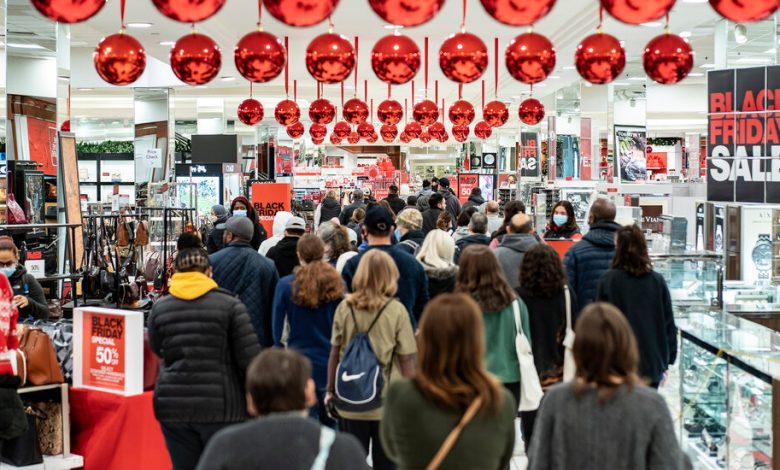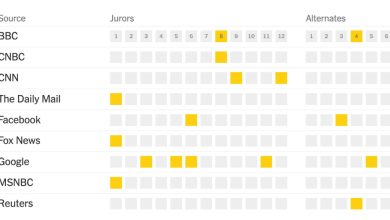Retailers’ Seasonal Hiring Plans Signal a Cooling Labor Market

As the most important selling season for retailers approaches, job applicants may feel a chill.
Macy’s and Dick’s Sporting Goods plan to hire fewer seasonal workers after a surge in the past two years, when shoppers thronged to stores after pandemic lockdowns and employers struggled to keep up. Many retailers have dropped the incentives they used over the past few years to bring workers in the doors, such as signing or referral bonuses and steeper employee discounts.
The career site Indeed said that searches for seasonal jobs were up 19 percent from last year, but that listed positions were down 6 percent. Companies helping businesses find temporary workers note that major retailers have been slower to release hiring plans this year. And on Indeed, fewer job postings are described as urgent needs.
Seasonal hiring helps retailers handle the increased shopping during the fourth quarter, often referred to as “peak season.” Sales in November and December can account for a quarter of some retailers’ annual revenue. In the weeks leading up to Christmas, foot traffic in stores and online shopping are usually at their height.
Early estimates point to an increase in retail spending this holiday season, but not at the fast pace of recent years.
Some economists and consultants see the trends in hiring and pay as a sign that the red-hot labor market of the past couple of years has cooled. Retailers’ work forces, unsteady throughout the Covid-19 pandemic, are starting to stabilize. As inflation erodes shoppers’ budgets and confidence — and savings from pandemic relief programs are drawn down — the hiring plans may be part of a cautious approach that extends to inventories and sales projections.
“The seasonal hiring market looks a whole lot more like 2019 than those pandemic bounce-back years,” said Nick Bunker, director of North American economic research for Indeed. “I really do think this is emblematic broadly of what we’re seeing in the U.S. labor market, where demand for workers overall is fairly strong but down from where it was in the last year and a half.”
Macy’s is aiming to hire 38,000 workers, 3,000 below its 2022 plan. In 2021, Macy’s said it aimed to hire 76,000 people — in both permanent roles and seasonal jobs — during the holiday season. Of those positions, 48,000 were temporary.
Dick’s said it would hire up to 8,600 seasonal workers, down from targets of 9,000 last year and 10,000 in 2021 — and up only slightly from 8,000 in 2019.
Target and United Parcel Service plan to hire the same number of workers as last year, about 100,000 each. In a statement, Target said its seasonal associates would supplement the hiring it had done throughout the year to staff up its stores and supply chain facilities.
“This year, we are starting the season with stability in our work force and a continued commitment to scheduling flexibility for our team, which has helped us retain team members and create a more experienced work force,” the company said in a post on its blog.
Walmart, the nation’s biggest retailer, echoed that sentiment.
“I’m also excited that we’re staffed and ready to serve customers this holiday season,” Maren Dollwet Waggoner, senior vice president of people at Walmart U.S., said in a post on LinkedIn. “We’ve been hiring throughout the year to be sure we’re ready to serve customers however they want to shop.”
A Walmart spokeswoman added that if a store had additional staffing needs during the holiday season, it would offer extra hours to current employees before looking externally. Walmart did not say how many seasonal workers it planned to hire this year, as it did in years past. (In 2022, it said it was looking to fill 40,000 seasonal positions, including truck drivers and call center workers.)
Amazon is a notable exception, saying it will hire more seasonal workers this year — 250,000, up from 150,000 last year. It also said that a $1.3 billion investment would bring the average hourly wage of those jobs to more than $20.50 and that it would still offer signing bonuses in some locations.
Matching staffing to demand helps ensure that retailers eke out as many sales as they can.
Seasonal workers are “the folks that are on the front lines of their business,” said John Long, North America retail sector leader at the consulting firm Korn Ferry, adding that aside from a store’s inventory, they “are going to be the make-or-break piece of the equation of whether the retailer makes their numbers or they don’t.”
After paring their work forces during the worst of the pandemic, employers in the retail and hospitality industries scrambled to fill open positions as workers sought more flexibility, switched companies frequently or stood on the sidelines. To get back to prepandemic staffing, retailers have used evergreen requisitions — continually displayed postings advertising essential roles that often need to be filled — and have started hiring seasonal workers as early as August.
They have also given more hours to part-time workers and relaxed qualifications. To reduce turnover, many companies have bumped up their base wages for hourly positions.
These factors have complicated the explanation for reduced seasonal hiring this year, said Melissa Hassett, a vice president at Manpower Group who works with large retailers, logistics and distributors across the country.
“If you’re always hiring, you’re just not going to see an increase in postings happen very often,” she said. “So sometimes when you look at the increase in postings for retail it’s not as accurate as you think it is.”
But there is also a feeling that the leverage of retail job applicants will fade.
“In the past it felt like the workers had a lot more upper hand in terms of being able to demand what they need,” Yong Kim, founder of the staffing platform Wonolo, said. That dynamic has changed, especially for temporary positions.
“There is definitely more tightening around companies wanting to hold off on hiring unless they really need to” and waiting to see how the fourth quarter pans out, Mr. Kim said.




